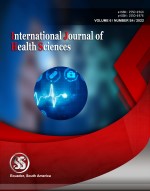A conceptual paper on Lahore-Pakistan pregnancy cohort study
Keywords:
Cohort study, HFIAS, LPCS, PregnancyAbstract
Pakistan is among the countries with a high rate of fertility and maternal mortality, and it's in a contract with sustainable development goals (SDGs) to achieve its 5th goal (achieve gender equality and empower all women and girls). Remaining this rate high with the availability of evidence-based strategies for reducing maternal mortality and advances in medical technology in Pakistan, this study will attempt to explore the methodology of the Lahore Pregnancy Cohort Study (LPCS). The objectives of the study were to determine the nutritional status, environmental factors (socio-economic status and food insecurity) and psychological status (depression and anxiety) of pregnant women. Moreover, the study will be an ongoing two-year prospective cohort study of Pakistani pregnant women in their 2nd trimester from the outpatient department of Fatima Memorial Hospital Lahore, Pakistan. Meanwhile, during pregnancy, their interview was conducted three times in the 2nd and 3rd trimesters of pregnancy and postpartum.
Downloads
References
Gebremichael, B., Misgana, T., Tamiru, D., Tariku, M., Tesfaye, D., Alemu, D., Weldesenbet, A. B., & Dheresa, M. (2022). Undernutrition and associated factors among rural pregnant women in Eastern Ethiopia: Https://Doi.Org/10.1177/20503121221104430, 10, 205031212211044. https://doi.org/10.1177/20503121221104430
Ghaffar, R., Iqbal, Q., Khalid, A., Saleem, F., Hassali, M. A., Baloch, N. S., Ahmad, F. ud D., Bashir, S., Haider, S., & Bashaar, M. (2017). Frequency and predictors of anxiety and depression among pregnant women attending tertiary healthcare institutes of Quetta City, Pakistan. BMC Women’s Health, 17(1), 1–8. https://doi.org/10.1186/S12905-017-0411-1/TABLES/4
Khalid N, Aslam Z, Kausar F, Irshad H, A. P. (2017). Maternal Malnutrition and Its Kick on Child Growth: An Alarming Trim for Pakistan. https://www.primescholars.com/articles/maternal-malnutrition-and-its-kick-on-childgrowth-an-alarming-trim-for-pakistan-94060.html
National Nutrition Survey. (2018). National Nutrition Survey 2018 | UNICEF Pakistan. Retrieved May 24, 2022, from https://www.unicef.org/pakistan/national-nutrition-survey-2018
Oei, T. P. S., Sawang, S., Goh, Y. W., & Mukhtar, F. (2013). Using the Depression Anxiety Stress Scale 21 (DASS-21) across cultures. International Journal of Psychology, 48(6), 1018–1029. https://doi.org/10.1080/00207594.2012.755535
Sadiq, K., Mahmood, B., Kureishy, S., Ariff, S., Mustafa, G., Khan, G. N., Umer, M., Memon, Z., Janjua, N., Soofi, S., & Bhutta, Z. (2020). Geographic and Socioeconomic Disparities in Nutritional Status of Women in Pakistan: Secondary Analysis from Pakistan National Nutrition Survey. 1–16.
Salarkia, N., Abdollahi, M., Amini, M., & Neyestani, T. R. (2014). An adapted Household Food Insecurity Access Scale is a valid tool as a proxy measure of food access for use in urban Iran. Food Security 2014 6:2, 6(2), 275–282. https://doi.org/10.1007/S12571-014-0335-7
Savard, C., Lemieux, S., Lafrenière, J., Laramée, C., Robitaille, J., & Morisset, A. S. (2018). Validation of a self-administered web-based 24-hour dietary recall among pregnant women. BMC Pregnancy and Childbirth, 18(1), 1–10. https://doi.org/10.1186/S12884-018-1741-1/TABLES/5
Sciences, T. M. of H., Zimbabwe, U. of, Harare, Sciences, Z. H. of H., Zimbabwe, U. of, Harare, Sciences, Z. M. of H., Zimbabwe, U. of, Harare, Sciences, Z. M. of H., Zimbabwe, U. of, Harare, Sciences, Z. N. of H., Zimbabwe, U. of, Harare, & Zimbabwe. (2020). Maternal Under-Nutrition: A Concept Paper. Open Access Library Journal, 07(11), 1–11. https://doi.org/10.4236/OALIB.1106183
Suryasa, I. W., Rodríguez-Gámez, M., & Koldoris, T. (2022). Post-pandemic health and its sustainability: Educational situation. International Journal of Health Sciences, 6(1), i-v. https://doi.org/10.53730/ijhs.v6n1.5949
Tyagi, M. S., Singh Toteja, G., & Bhatia, N. (2017). Maternal Nutritional Status and Its Relation with Birth Weight. International Journal of Health Sciences & Research (Www.Ijhsr.Org), 7(8), 422. www.ijhsr.org
Santi, L. K. S., Sudewi, A. A. R., Duarsa, D. P., & Lesmana, C. B. J. (2021). The relationship of pregnancy massage to the rate of anxiety depression and stress in pregnant women. International Journal of Health & Medical Sciences, 4(2), 208-214. https://doi.org/10.31295/ijhms.v4n2.1699
World Health Organization. (2019). Global status report on alcohol and health 2018. World Health Organization.
Published
How to Cite
Issue
Section
Copyright (c) 2022 International journal of health sciences

This work is licensed under a Creative Commons Attribution-NonCommercial-NoDerivatives 4.0 International License.
Articles published in the International Journal of Health Sciences (IJHS) are available under Creative Commons Attribution Non-Commercial No Derivatives Licence (CC BY-NC-ND 4.0). Authors retain copyright in their work and grant IJHS right of first publication under CC BY-NC-ND 4.0. Users have the right to read, download, copy, distribute, print, search, or link to the full texts of articles in this journal, and to use them for any other lawful purpose.
Articles published in IJHS can be copied, communicated and shared in their published form for non-commercial purposes provided full attribution is given to the author and the journal. Authors are able to enter into separate, additional contractual arrangements for the non-exclusive distribution of the journal's published version of the work (e.g., post it to an institutional repository or publish it in a book), with an acknowledgment of its initial publication in this journal.
This copyright notice applies to articles published in IJHS volumes 4 onwards. Please read about the copyright notices for previous volumes under Journal History.
















